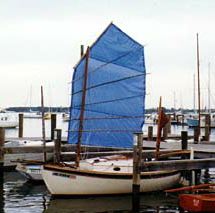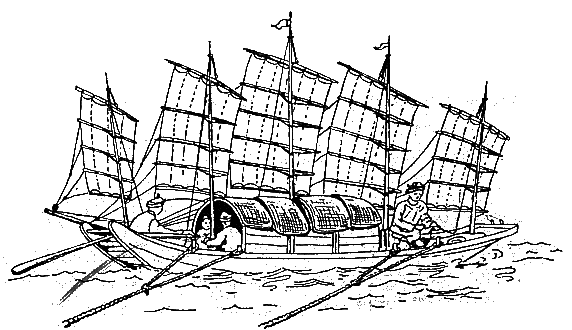![]() ...to
Plywood Boats or to The
Cheap Page or to The
Odd Sails
...to
Plywood Boats or to The
Cheap Page or to The
Odd Sails
 Photo courtesy Mark Anderson and his mighty stereopticon.
|
|||||||||||||||||||||||||||||||||||||||||||||||||||||||||||||||||||||||||||||||||||||||||||||||||||||||||||||
|
Boom:
|
10 ft |
||
|
Sail Area:
|
111 sq ft (Aspect ratio is about 1.1) |
||
|
Spars: |
|||
|
Yard:
|
(66% of Boom) |
70 deg angle to Luff |
|
|
Yard Offset |
|
Distance from peak of Yard to the Luff perpendicular |
|
|
Battens: |
|||
|
|
10 ft |
45 deg (approx) |
|
|
|
" |
30 deg " |
|
|
|
" |
20 deg " |
|
|
|
" |
10 deg " |
|
|
|
" |
05 deg " |
|
|
Boom |
10 ft |
< 5 deg |
|
|
Panels: |
|||
|
Luff Overall: |
|
||
|
Each Panel |
|
Each Panel's Luff |
|
|
Head
|
|
Panel 6 |
|
|
Upper Roach
|
|
Panel 6 (Yard Peak to |
|
|
Leech "L"
|
(50% of Yard) |
Batten 4 - 5 |
|
|
Leech Dimension for Panel: |
|||
|
|
|
Batten 3 - 4 |
|
|
|
|
Batten 2 - 3 |
|
|
|
|
Batten 1 - 2 |
|
|
|
|
Panel 1 |
|
This information is from Practical Boat Owner 1/92, "Junk Rig Decoded". Many thanks to Peter Berrie for sending me a copy of the article.Making the Sail
|
|
Spars are laid on the ground and staked in position. A rope (heavy grey line) forms a framework along the luff and leech and along the boom and yard. Reddish used 5mm polyester rope (about 3/16"). This frame of rope is interesting, because it allows a very taut luff without depending on the sailcloth to hold the tension. It also spreads the stresses on the leech directly to the battens. The sail itself was made of a single polytarp cut to the proper shape and "hemmed with a thinner rope" (1/8" polyester would work; so would nylon or polyester webbing). He is not specific about lacings other than to say that the sail was then "stretched tight" and laced to the framework and the battens. I imagine this means sewing loops around the light hem rope and the boltropes with heavy sail twine. |
|
|
Worcester depicts a double-roping system used on the large sails, and if I can find the material I will add a scan of his diagram. It doesn't seem to be strictly necessary, but it would certainly add strength. This traditional approach includes a head batten laced to the sail. The head batten is then tied to the yard. From what I've read, I suspect this is because the yard was rarely removed from a vessel; the head batten is a surrogate yard which is used when laying out and constructing the sail. |
||
|
|
|
|
|
|
 |
|
|
COD & Bob Cavenagh
construct a 160 sq ft sail, per Reddish, in
about 4 hours. |
|
Sail on Bob's canoe yawl. The boom is swung toward the camera and is longer than it looks. It did work, though we had almost no wind, and not enough time to work out all the sheetlet lengths to our complete satisfaction. |
Camber?
Reddish also says that he picked batten sizes which would give him about a 10% camber in normal sailing conditions. On our 10-foot sail, the battens would bend so that they were about 1 foot out of line near the middle of the sail. (Make sure the boom is stiff enough that it does not bend, however). Photos of traditional Chinese sails show some bending, especially when sailing to windward.
Finally Reddish says he made each panel somewhat baggy simply by pushing it down in the middle as he attached the battens. The corners wrinkled some, he says, but that did not seem to cause any problems.
Update: 1998
This note comes from Bill Samson in Scotland. As it turns out, he was a student of Dr. Reddish some years back and was able to get an update for us. The main differences seem to be returning to rigid battens and adding some darts to the leech to give the panels a little shape.
Dear Craig,I had a long telephone conversation with Vincent Reddish this evening.
I asked him how he fixed the battens to the sail and he said he didn't - the sail is fixed to the battens! The sail is sewed on, with whipping twine, to the yard, boom and bolt-ropes. The battens are double - bamboo on each side of the sail. He puts a stitch in every six inches or so, using burgee cord, so that the sail is sandwiched between the battens.
He uses a 360 square foot polytarp sail, made in this way, on his Laurent Giles designed VERTUE cruiser. His original experiments were with a Laser-17. He was at pains to point out that his sail is quite different from Hasler/Macleod, being based directly on those found in Chinese boats.
His main reservation about polytarp is its lack of stretch compared with the Chinese material, so he has put in a little broadseaming along the leach - at each batten. [To give the panels some camber]
He firmly believes in rigid battens with as little bend as possible - that's what the Chinese use. The fan arrangement of the battens means that sail twist is converted into horizontal aerofoil sections and the amount of lift is controlled by how much twist you allow.
He mentioned something about the drive coming from vortices - particularly near the top of the sail. In fact the top panel of the sail behaves very like a crab-claw sail.
Just to show that Vincent isn't all theory and no practice, he took his VERTUE around Ireland last year single handed (over 1000 miles and only had to leave the cockpit once, to redo a knot that he'd tied badly in the first place). Not bad for a 67-year-old! Although his boat has a Bermudan rig available, he much prefers the convenience and comfort of his home-made polytarp junk sail - What he calls 'armchair sailing in a boat'!
For those on the list who've never heard of him, Dr Vincent Reddish is an eminent astrophysicist who was Astronomer Royal for Scotland, and Professor and head of the department of astronomy in Edinburgh University. Maybe his greatest claim to fame is that he managed to supervise me to successful completion of a PhD in 1971! <G> He is currently leading a world-wide network of scientists in a systematic investigation into the physics of dowsing - a real but, as yet, unexplained phenomenon.
-- Bill
Bill's Chebacco News: http://www.taynet.co.uk/users/wbs/chebacco.htm
|
|
|
|
|
|
|
|
|
|
|
|
|
 Maybe
it doesn't have to be as elaborate as this
lake-trawling sampan.
Maybe
it doesn't have to be as elaborate as this
lake-trawling sampan.![]() To
Plywood
Boats or to The
Cheap Page or to The
Odd Sails or to the Top.
To
Plywood
Boats or to The
Cheap Page or to The
Odd Sails or to the Top.
2.5 12/08/00 ..